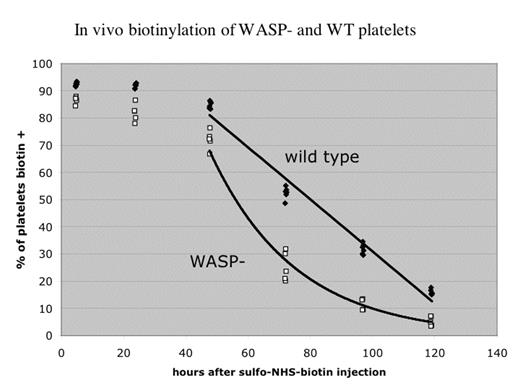Abstract
The thrombocytopenia seen in patients with the Wiskott-Aldrich Syndrome (WAS) is thought to be due primarily to rapid platelet consumption, and is markedly improved by splenectomy. While a murine model of WAS shows only mild thrombocytopenia, we have previously demonstrated rapid platelet turnover in this model; that splenectomy improves the platelet count in WASP-(C57Bl/6J) mice; and that the latter mice do not achieve the same platelet count found in splenectomized WT mice. Here we show that CMFDA-labeled WASP- platelets are consumed rapidly and exponentially in WT recipients, with an estimated lifespan of 18 hours (vs. 87 hours for WT platelets). WASP- platelets are consumed only slightly more slowly in splenectomized WT recipients (lifespan 28 hours, vs. 102 hr for WT platelets). On the C3H background, WASP- mice have normal platelet counts but show a similar rapid, exponential platelet consumption rate (lifespan 25 hours in either C3H or C57Bl/6J recipients, vs 85 hours for WT platelets). In vivo platelet biotinylation studies demonstrate less effective labeling of WASP- (C57Bl/6J) platelets than of WT platelets. After a plateau phase, in vivo labeled WASP- platelets show the same kind of rapid platelet turnover seen with ex vivo labeling (figure 1). Our results imply a three-fold increase in platelet production rate in WASP- mice on either background, consistent with the markedly increased splenic extramedullary hematopoiesis seen in WASP- mice. WASP- mice also show an increased number of bone marrow megkaryocytes, the ploidy distribution of which is normal. We conclude that WASP- mice demonstrate a significantly increased rate of extra-splenic platelet consumption that is largely (on the C57Bl/6 background) or completely (on the C3H background) compensated by increased platelet production. The ability of WASP- mice to compensate for their rapid platelet consumption, and the normal ploidy of their megakaryocytes, suggests that platelet production is not impaired by WASP deficiency in this model.
In vivo biotinylation of WASP-and WT platelets
Author notes
Corresponding author


This feature is available to Subscribers Only
Sign In or Create an Account Close Modal